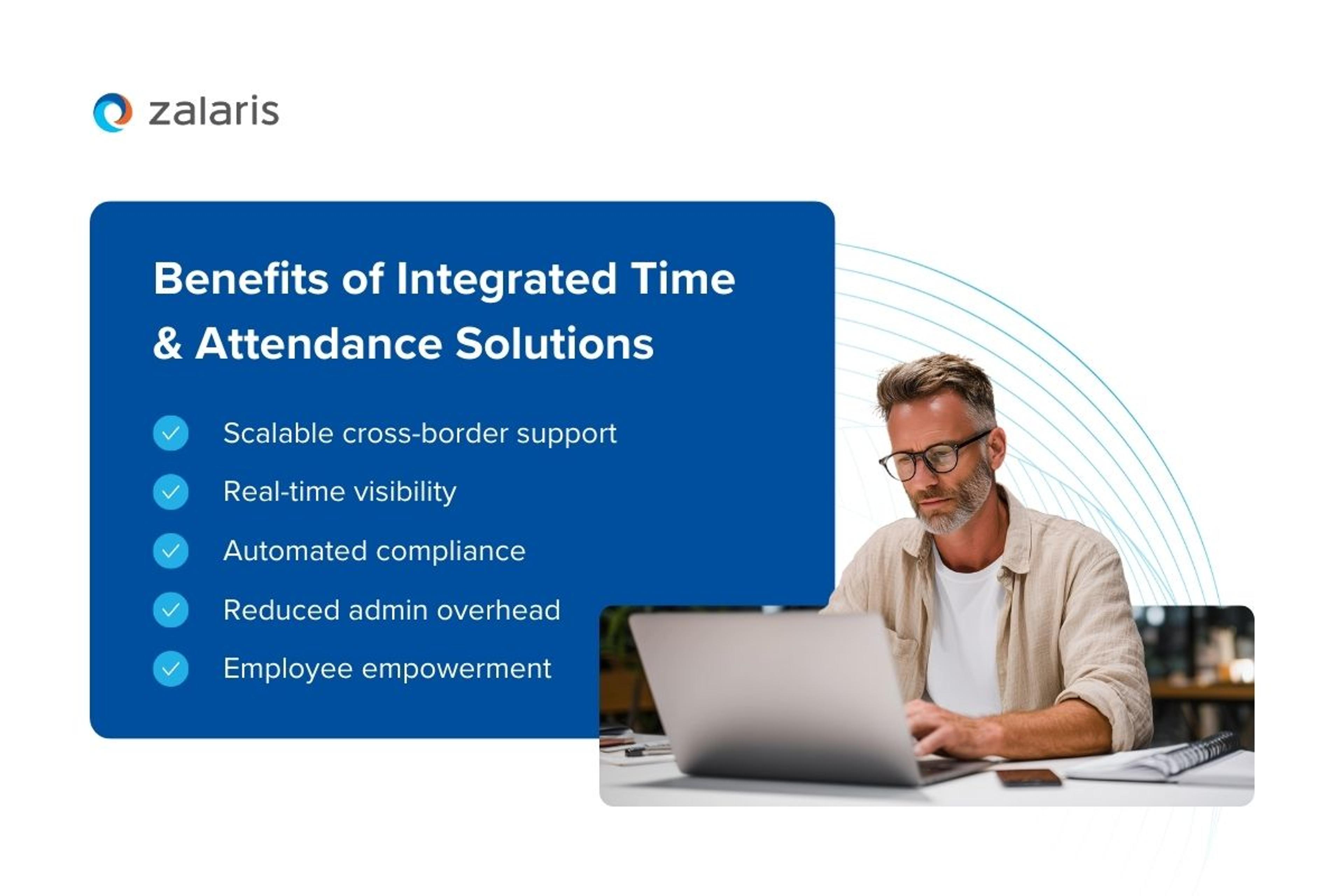Why time management is the last big HR risk
Time management is rarely the centrepiece of an HR transformation. While organisations invest heavily in upgrading payroll, recruitment, and performance tools, time tracking is often managed through legacy systems, isolated spreadsheets, or semi-manual processes.
Elliot Raba

As modern workforce management grows more complexwith hybrid models, part-time flexibility, union agreements, and cross-border operations, organisations need integrated time and HR solutions that improve daily administration and employee experiences.
Time mismanagement leads to payroll errors, compliance breaches, scheduling inefficiencies, and employee mistrust. And in a global environment where regulation is tightening and employee expectations are rising, these risks can no longer be left unaddressed.
Regulators across Europe and Australia have already taken notice. In the EU, the European Court of Justice has ruled that employers must implement “objective, reliable and accessible” systems to record actual working hours. In the UK, Working Time Regulations impose strict requirements around rest breaks, maximum weekly hours, and accurate recordkeeping. Australia’s Fair Work Ombudsman employers must retain accurate time and pay records for seven years, and records must be accessible, legible, and unaltered unless correcting errors.And yet, many enterprise organisations still run time on tools that weren’t built for modern realities - let alone designed to prevent risk.
In this blog, we’ll examine the hidden pain points in time and attendance management, and why addressing them is not only a compliance requirement, but a strategic opportunity.
Hidden pain point #1: Practical challenges in accuratetime tracking
While most organisations have a time and attendance system in place, ensuring that data is consistently accurate, complete, and aligned with workforce prioritiesremains a persistent challenge.
In practice, even well-designed processes can encounterchallenges, particularly in organisations managing varied employment types, multiple locations, or frequent schedule changes. As workforce needs evolve, many existing systems no longer support the level of flexibility and efficiencyrequired for complex time management.
Common issues include:
- Fragmented data entry points: Time may be captured through physical terminals, mobile apps, or spreadsheets. When systems are not integrated, data reconciliation becomes a manual and error-prone task. Without HR integrations with time tracking,inconsistencies grow quickly.
- Lack of real-time visibility: Many systems do not provide HR or operations teams with immediate insight into planned vs. actual hours, overtime thresholds, or time tracking compliance triggers. This makes it difficult to identify issues before they affect payroll or compliance.
- Multiple time rules within a single workforce: Different employee groups follow different rules - whether it’s part-time hours, seniority-based shifts, on-call pay, or time off in lieu. Managing these variations, especially across regions or agreements, goes beyond what most basic time scheduling tools can handle.
- Limited access to historical records: Many systems do not store or surface time data in a way that allows HR teams to quickly review past schedules, adjustments, or anomalies. This makes it difficult to resolve employee queries, respond to audits, or analyse workforce patterns over time.
A robust, integrated time and HR setup doesn’t just record hours - it reflects how work is actually completed across roles, regions, and contract types. The goal isn’t just to meet compliance requirements, but to create a more transparent, efficient, and resilient way of managing time.

Hidden pain point #2: Fragmented systems slow operations and increase risk
Many organisations still manage time and attendance through a patchwork of standalone systems, spreadsheets, and manual workflows. When time tracking is not fully integrated with HR, payroll, or workforce management systems, the result is data duplication and inefficiency.
Disjointed systems lead to frequent data mismatches, requiring manual reconciliation between platforms. This slows down payroll processing, increases the likelihood of errors, and places unnecessary burden on HR and operations teams. Over time, this fragmentation limits an organisation’s ability to scale HR processes across regions or markets.
Disjointed systems don’t just impact the organisation – A Quickbase report found that 70% of employees spend over 20 hours per week on working across disconnected systems, instead of focusing on meaningful tasks.
Accurate, compliantand unified time management provides real-time visibility into staff availability and the ability to adapt to last-minute changes in schedules. Without these capabilities, organisations face ongoing challenges with overstaffing and understaffing.
By adopting an enterprise workforce scheduling solution that integrates time tracking with HR processes, organisations can reduce administrative overhead, improve forecasting accuracy, and enable proactive decision-making. This approach not only minimises costly errors but also supports operational continuity, allowing HR and management teams to focus on strategic priorities instead.

Hidden pain point #3: Lack of transparency erodes employee trust
Accurate and transparent time tracking is essential for maintaining employee trust. Today’s workforce expects mobile-friendly access to schedules, real-time updates on worked hours, and visibility into time-off balances. When these expectations are unmet, trust in HR process (and the organisation overall) can quickly erode.
Common issues that undermine trust include:
- Discrepancies between actual and recorded time
- Delays in correcting errors
- Perceived unfairness in shift assignments or time-off approvals.
For example, employees who redeem time off in lieu (TOIL) but do not see it promptly reflected may feel their concerns are overlooked.
Research from Deloitte indicates that only 37% of employees feel very confident that their organisation uses their time and workforce data responsibly.Furthermore, when employees understand the purpose of data collection and have access to transparent records, trust is boosted by 35%.
Implementing a compliance-ready time tracking system integrated with HR functions provides employees with direct, timely access to their time sheets and schedules. This transparency empowers employees, reduces administrative workload, and fosters a culture of fairness and accountability.
Hidden pain point #4: Cross-border complexity escalates risk and overhead
As organisations expand into new regions, time management becomes significantly more complex. Local labour laws, public holidays, overtime thresholds, and contractual entitlements can differ widely across regions and markets. Yet many time tracking systems are not built to manage this variation effectively.
According to a recent analysis by Payroll Central, organisations processing payroll in just one country face a 24% chance of incurring compliance fines, but that risk jumps sharply to between 50% and 67% when they operate across multiple countries. This underscores the importance of an integrated time solution when operating across regions.
Without built-in localisation, HR teams are forced to manually apply different time rules for each country or employee group. This increases the risk of payroll errors, compliance breaches, and employee dissatisfaction, particularly in countries with strict labour regulations or union agreements.
Differences in currency and compensation further complicate the process. Employees in different regions may need to be paid in local currencies, with time records aligned to accurate exchange rates and contract-specific calculations. Most legacy systems do not support this level of automation.Seniority-based shift planning, time off in lieu (TOIL), or variable entitlements require flexible logic that many basic systems cannot accommodate.

Rethinking timeand attendance as a strategic advantage
The risks of poor time management are clear, but the right solution can turn this complexity into a competitive advantage. Time data, when accurately captured and integrated, enables better planning, ensures compliance, and improves employee engagement.
Zalaris offers Time and Attendance systemsbuilt to support both global operations and local needs. Our solutionis designed to handle the realities of workforce scheduling across countries, employment types, and working models.
Organisations benefit from:
- Global solutions with local depth: Our systems are designed for scale but localised to reflect country-specific rules, holidays, union agreements, and entitlements.
- Integrated time and payroll: Time management is seamlessly embedded into the Zalaris Cloud Payroll solution, ensuring accuracy and reducing reconciliation efforts.
- User-friendly, role-based apps: Employees, managers, and HR teams can leverageintuitive interfaces tailored to their needs with role based access.
- Time tools on-the-go: We offer both desktop and mobile accessibility for hassle-free time registration anytime, anywhere.
- Efficient approvals and reporting: Fast data input, real-time visibility, and configurable approval workflows allow better control with less administrative overhead.
- Support in local languages: Time tracking should work the way your people do. Our solutions offer multilingual support to increase adoption and accuracy.
- Compliance by design: Zalaris combines secure integration with deep knowledge of local legislation, ensuring that time data flows into payroll and reporting processes reliably and in line with regulatory standards.
A compliance-ready time and attendance solution connects people, processes, and performance, reducing risk and boosting efficiency. Get in touch with us to find out how Zalaris can help you integrate time with core HR and payroll, and drive strategic impact.
Frequently asked questions (FAQ)
- What is an integrated time and HR solution, and why is it important?
An integrated time and HR solution combines time tracking with core HR processes like payroll and scheduling. This integration reduces errors, improves compliance-ready time tracking, and streamlines workforce scheduling, making it essential for managing complex time management needs efficiently. - How can a compliance-ready time and attendance system reduce legal and financial risks?
A compliance-ready time and attendance system ensures accurate employee time sheets and applies local labour rules automatically. This prevents breaches of working time regulations, supports union agreements, and protects organisations from costly fines or wage disputes. - What challenges do organisations face without a comprehensive time tracking solution?
Without a comprehensive time tracking solution, organisations often deal with fragmented data, payroll inaccuracies, scheduling inefficiencies, and eroding employee trust. Legacy systems or isolated spreadsheets increase the risk of errors and reduce visibility into workforce availability. - How do enterprise workforce scheduling solutions support complex, cross-border operations?
Enterprise workforce scheduling solutions designed for complex organisations provide localisation for multiple countries, handle different currencies and contracts, and integrate seamlessly with HR and payroll systems. This helps manage cross-border complexities while maintaining compliance and operational efficiency.
Related content

Elliot Raba
Enterprise Sales Executive
Elliot is a dynamic and results-driven Enterprise Sales Executive at Zalaris UK&I, where he excels in crafting innovative solutions that address the unique needs of his clients. With a keen understanding of the intricacies of enterprise level operations, Elliot leverages his extensive industry knowledge to drive business growth and foster lasting partnerships.
Table of Contents
- Hidden pain point #1: Practical challenges in accuratetime tracking
- Hidden pain point #2: Fragmented systems slow operations and increase risk
- Hidden pain point #3: Lack of transparency erodes employee trust
- Hidden pain point #4: Cross-border complexity escalates risk and overhead
- Rethinking timeand attendance as a strategic advantage
- Frequently asked questions (FAQ)

